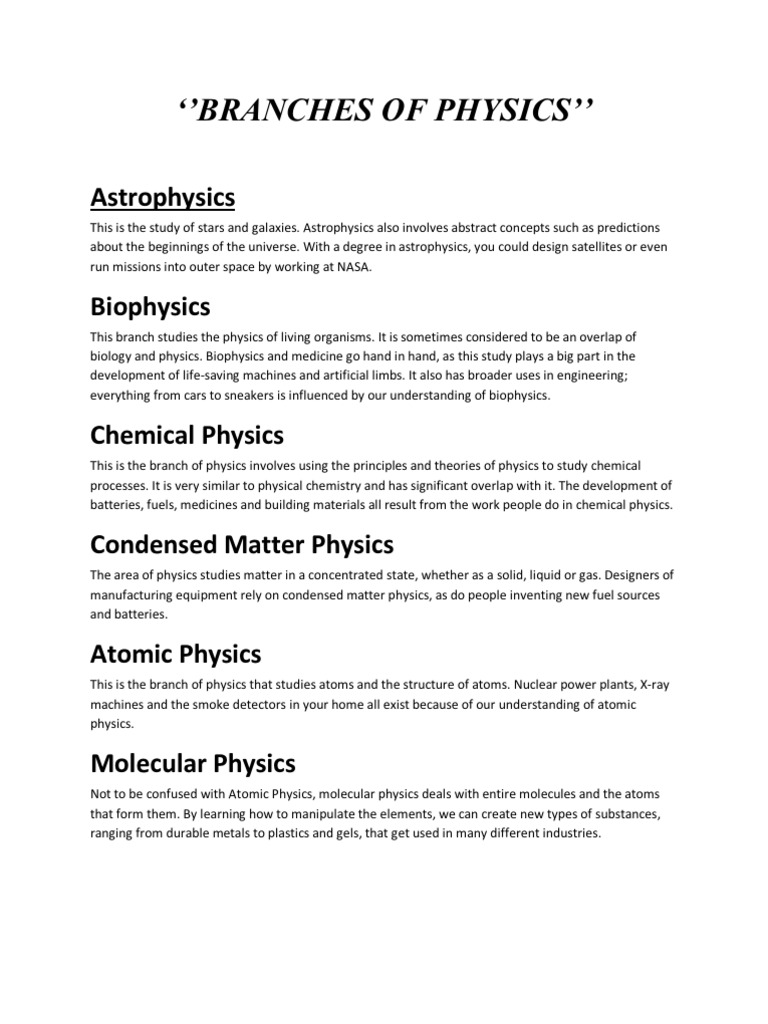Physics, the bedrock of the natural sciences, is an expansive field that endeavors to elucidate the fundamental principles governing the universe. The discipline is broadly categorized into several branches, each focusing on distinct aspects of matter and energy. Engaging with these branches not only enriches one’s comprehension of the physical world but also enhances the technological and theoretical frameworks essential for scientific progress.
In this examination, we will delve into the various branches of physics, illustrating their unique characteristics, methodologies, and applications. This exploration will illuminate how each branch contributes to our overarching understanding of the cosmos.
1. Classical Mechanics
Classical mechanics, often regarded as the cornerstone of physics, studies the motion of bodies under the influence of forces. It hinges on the laws articulated by Sir Isaac Newton, which govern the movement of everyday objects. This branch encompasses a plethora of phenomena, from the trajectories of celestial bodies to the mechanics of structures and machinery.
Core principles such as inertia, momentum, and energy conservation provide the foundation for classical mechanics applications in engineering, aerospace, and mechanics. Additionally, more advanced concepts, including chaos theory and non-linear dynamics, have emerged from foundational principles, extending their application to complex systems in both natural and artificial contexts.
2. Thermodynamics
Thermodynamics explores the intricate relationships between heat, work, temperature, and energy. At its core, it investigates how energy is converted from one form to another and aims to understand the laws governing energy transfer. The laws of thermodynamics, particularly concerning energy conservation and entropy, serve as guiding principles across various scientific disciplines.
This branch elucidates practical applications, such as heat engines, refrigerators, and the principles underlying phase transitions. Moreover, it provides essential insights into the behavior of gases, liquids, and solids, forming a critical aspect of fields ranging from chemistry to engineering.
3. Electromagnetism
Electromagnetism is the branch that investigates electric and magnetic fields and their interactions with matter. From James Clerk Maxwell’s equations, which elegantly describe the behavior of electric and magnetic fields, to the principles of electromagnetic waves, this field has revolutionized our understanding of the physical world.
Applications of electromagnetism are ubiquitous; they span telecommunications, electronics, and medical technologies, such as magnetic resonance imaging (MRI). The exploration of phenomena ranging from static electricity to the propagation of light exemplifies the branch’s vast scope and its significance in both theoretical and applied physics.
4. Quantum Mechanics
Quantum mechanics ventures into the subatomic realm, challenging classical intuitions about the nature of reality. It delves into the probabilistic behavior of particles, elucidating phenomena such as wave-particle duality, quantum entanglement, and superposition. The peculiarities of quantum behavior manifest in the microscopic world, leading to advancements in chemistry, computer science, and nanotechnology.
This branch’s implications extend beyond academia; innovations such as quantum computing and quantum cryptography promise to transform technology fundamentally. Thus, understanding quantum mechanics is imperative for future breakthroughs in both scientific theory and technological application.
5. Relativity
Introduced by Albert Einstein, the theory of relativity encompasses both special and general relativity, revolutionizing our understanding of space, time, and gravity. Special relativity addresses the behavior of objects moving at relativistic speeds, positing profound implications for time dilation and length contraction. General relativity extends these ideas to include gravity as a curvature of space-time, providing a compelling framework for understanding cosmic phenomena.
The ramifications of relativity are profound, influencing astrophysics, cosmology, and GPS technology, which relies on relativistic corrections for accuracy. This branch challenges our perceptions of the universe, illustrating the interconnectedness of space and time.
6. Optics
Optics investigates the behavior and properties of light, encompassing both its wave-like and particle-like characteristics. This branch is pivotal in exploring phenomena such as reflection, refraction, diffraction, and interference. The practical applications of optics are abundant, finding relevance in fields like photography, vision correction, and optical fibers for data transmission.
Recent advancements, including laser technology and fiber optics, underscore the importance of this branch in modern science and communication. Quantum optics, a subfield, intertwines with quantum mechanics, leading to groundbreaking discoveries and applications in metrology and imaging.
7. Astrophysics
Astrophysics merges the principles of physics with celestial phenomena, seeking to understand the universe’s origin, evolution, and fundamental components. It examines everything from the life cycles of stars to the dynamics of galaxies and the cosmic microwave background radiation. Astrophysics employs a variety of methodologies, including observational techniques and theoretical models, to elucidate the mysteries of the cosmos.
This branch not only enhances our comprehension of the universe but also fuels technological advancements, contributing to satellite technology, space exploration, and the search for extraterrestrial life.
8. Nuclear Physics
Nuclear physics focuses on the constituents and interactions of atomic nuclei. The study of nuclear forces, radioactive decay, and nuclear reactions has significant implications in both energy production and medical applications, such as cancer treatment through radiation therapy. The field also plays a crucial role in understanding fundamental particle interactions and the creation of elements within stars.
In addition to its practical applications, nuclear physics contributes to the development of groundbreaking technologies, including nuclear fission and fusion, thereby influencing energy policy and international relations.
In summary, the exploration of the various branches of physics offers a comprehensive understanding of the universe’s fundamental principles and phenomena. Each branch encapsulates a unique domain of study, enriching our intellectual landscape and driving technological innovation. The synergy among these fields fuels progress in scientific inquiry, demonstrating the intricate tapestry of the physical world around us.












